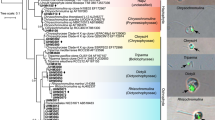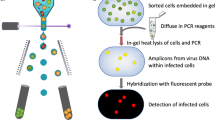Abstract
The recent discovery of photosynthetic picoplankton has changed our understanding of marine food webs1. Both prokaryotic2,3 and eukaryotic4,5 species occur in most of the world's oceans and account for a significant proportion of global productivity6. Using shipboard flow cytometry, we have identified a new group of picoplankters which are extremely abundant, and barely visible using traditional microscopic techniques. These cells are smaller than the coccoid cyanobacteria and reach concentrations greater than 105 cells ml–1 in the deep euphotic zone. They fluoresce red and contain a divinyl chlorophyll a-like pigment, as well as chlorophyll b, α-carotene, and zeaxanthin. This unusual combination of pigments, and a distinctive prokaryotic ultrastructure, suggests that these picoplankters are free-living relatives of Prochloron7. They differ from previously reported prochlorophytes—the putative ancestors of the chloroplasts of higher plants—in that they contain α-carotene rather than β-carotene and contain a divinyl chlorophyll a-like pigment as the dominant chlorophyll.
This is a preview of subscription content, access via your institution
Access options
Subscribe to this journal
Receive 51 print issues and online access
$199.00 per year
only $3.90 per issue
Buy this article
- Purchase on Springer Link
- Instant access to full article PDF
Prices may be subject to local taxes which are calculated during checkout
Similar content being viewed by others
References
Photosynthetic Picoplankton (eds Platt, T. & Li, W. K. W.) Can. Bull. Fish. Aquat. Sci. Vol. 214 (1986).
Johnson, P. W. & Sieburth, J. McN. Limnol. Oceanogr. 24, 928–935 (1979).
Waterbury, J. B., Watson, S. W., Guillard, R. R. L. & Brand, L. E. Nature 277, 293–294 (1979).
Johnson, P. W. & Sieburth, J. McN. J. Phycol. 18, 318–327 (1982).
Murphy, L. S. & Haugen, E. M. Limnol. Oceanogr. 30, 47–58 (1985).
Platt, T., Subba Rao, D. V. & Irwin, B. Nature 301, 702–704 (1983).
Lewin, R. A. & Withers, N. W. Nature 256, 735–737 (1975).
Olson, R. J., Vaulot, D. & Chisholm, S. W. Deep Sea Res. 32, 1273–1280 (1985).
Olson, R. J., Chisholm, S. W., Zettler, E. R. & Armbrust, E. V. Deep Sea Res. 35, 425–440 (1988).
Herbland, A. & Voituriez, B. J. mar. Res. 37, 87–101 (1979).
Lewin, R. A. in The Prokaryotes Vol. 1 (eds Starr, M. P., Stolp, H., Truper, H. G., Balows, A. & Schlegel, H. G.) 257–266 (Springer, Berlin, 1981).
Waterbury, J. B., Watson, S. W., Valois, F. W. & Franks, D. G. in Photosynthetic Phyloplanklon (eds Platt, T. & Li, W. K. W.) 71–120 (Can. Bull. fish. aquat. Sci., Ottawa, 1986).
Watson, S. W., Valois, F. W. & Waterbury, J. B. in The Prokaryoles (eds Starr, M. P., Stolp, H., Truper, H. G., Balows, A. & Schlegel, H. G.) 1005–1022 (Springer, Berlin, 1981).
Ward, B. B. J. mar. Res. 40, 1155–1172 (1982).
Goodwin, T. W., The Biochemistry of Carolenoids Vol. 1, second edition (Chapman and Hall, London, 1980).
Guillard, R. R. L., Murphy, L. S., Foss, P. & Liaaen-Jensen, S. Limnol. Oceanogr. 30, 412–414 (1985).
Foss, P. R. A., Lewin, S. & Liaaen-Jensen, S. Phycologia 26, 142–144 (1987).
Withers, N. W. et al. Proc. natn. Acad. Sci. U.S.A. 75, 2301–2305 (1978).
Burger-Wiersma, T., Veenhuis, M., Korthals, H. J., Van de Wiel, C. C. M. & Mur, L. R. Nature 320, 262–264 (1986).
Wood, A. M. J. Phycol. 15, 330–332 (1979).
Gieskes, W. W. & Kraay, G. W. Limnol. Oceanogr. 28, 757–766 (1983).
Bazzaz, M. B. Photobiochem. Photobiophys. 2, 199–207 (1981).
Bazzaz, M. B. & Brereton, R. G. FEBS Lett. 138, 104–108 (1982).
Strickland, J. D. H. & Parsons, T. R. A Practical Handbook of Seawater Analysis, second edition (Bull. 167, Fish. Res. Bd. Can., Ottawa, 1972).
Fitzwater, S. E., Knauer, G. A. & Martin, J. H. Limnol. Oceanogr. 27, 544–551 (1982).
Li, W. K. W. in Photosynthetic Phytoplankton (eds Platt, T. & Li, W. K. W.) 251–286 (Can. Bull. fish, aqual. Sci., Ottawa, 1986).
Mantoura, R. F. C. & Llewellyn, C. A. Analyt. chim. Acta 151, 297–314 (1983).
Davies, B. H. in Chemistry and Biochemistry of Plant Pigments Vol. 2 (ed. Goodwin, T. W.) 38–165 (Academic, London, 1976).
Author information
Authors and Affiliations
Rights and permissions
About this article
Cite this article
Chisholm, S., Olson, R., Zettler, E. et al. A novel free-living prochlorophyte abundant in the oceanic euphotic zone. Nature 334, 340–343 (1988). https://doi.org/10.1038/334340a0
Received:
Accepted:
Published:
Issue Date:
DOI: https://doi.org/10.1038/334340a0
This article is cited by
-
Understanding opposing predictions of Prochlorococcus in a changing climate
Nature Communications (2023)
-
Terrestrial and marine influence on atmospheric bacterial diversity over the north Atlantic and Pacific Oceans
Communications Earth & Environment (2022)
-
Exploring Newer Biosynthetic Gene Clusters in Marine Microbial Prospecting
Marine Biotechnology (2022)
-
When maths meets phytoplankton ecology
Nature Ecology & Evolution (2021)
-
Phytoplankton community structuring and succession in a competition-neutral resource landscape
ISME Communications (2021)
Comments
By submitting a comment you agree to abide by our Terms and Community Guidelines. If you find something abusive or that does not comply with our terms or guidelines please flag it as inappropriate.



